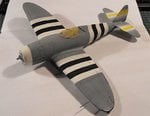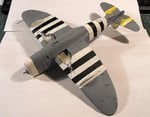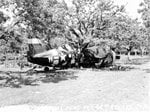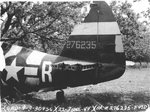yep some nice progress Dogsbody
Navigation
Install the app
How to install the app on iOS
Follow along with the video below to see how to install our site as a web app on your home screen.
Note: This feature may not be available in some browsers.
More options
You are using an out of date browser. It may not display this or other websites correctly.
You should upgrade or use an alternative browser.
You should upgrade or use an alternative browser.
P-47 'Bridge Buster', 1/48th scale, 9th Air Force Diorama. (1 Viewer)
- Thread starter Airframes
- Start date
Ad: This forum contains affiliate links to products on Amazon and eBay. More information in Terms and rules
More options
Who Replied?- Thread starter
- #82
Airframes
Benevolens Magister
And just for clarity's sake, resin is what some of us used to scrape from a smoking device to catch a buzz when there were no, (Ahem), herbs around.
Just sayin'!
Photo-etch? what the hell was that?
We used bits and pieces of brass screen, (also, oddly enough, from "smoking devices") for air intake filters.
A clicker ball point pen has many useful parts to the scratchbuilder!
You can take any common device, smash it up, and I can find usage for most of it in scratching!
There was, (and still is) a satisfaction in hunting out the cool uses for everyday crap and finding a way to put them in a model.
Your'e dead right there Paul. A company have done just that, and built the whole thing from bits and pieces of ball-point pen, scrap mesh and other household goods. I think they called it the F-35 ...............
Crimea_River
Marshal
Incoming!
- Thread starter
- #84
Airframes
Benevolens Magister
Well, you've got to have a laugh, it's CHRISTMAS.
And if that word offends anyone - tough sh*t !
I don't get offended by other people's festival titles, so they shouldn't tell me what I can and can't say!
And if that word offends anyone - tough sh*t !
I don't get offended by other people's festival titles, so they shouldn't tell me what I can and can't say!
- Thread starter
- #85
Airframes
Benevolens Magister
The AEAF stripes are done, and are ready to be masked, with 'cut outs' for the fuselage code letters. Once that's done, and the nose band masked, it'll be ready for spraying the Olive Drab upper surfaces.
Glenn and George very kindly sent me some stuff on 9th Air Force Thunderbolts, meeting my fairly tight requirements concerning colour schemes, and I've settled on the P-47D-15-RE, serial number 42-76235, code B8 - R, of the 379th FS, 362nd FG, flown by Lt. Robert Kelso(*), and operating from the ALG at Headcorn, Kent, in June 1944.
The photo George sent, an example of which is shown below, included the caption stating the aircraft had been hit by ground fire whilst operating over France on June 22, 1944, and managed to get back across the Channel, crash-landing in an orchard at High Halden.
Further research revealed a second photo, showing the tail unit, which had a lighter-coloured rudder trim tab, and, digging further, I discovered that this was in the Squadron colour, yellow, although evidently a different shade to the yellow of the serial number.
I was also able to establish that aircraft from this Squadron were mainly in Olive Drab at this period (the other two squadrons of the Group having bare metal aircraft), and until quite late in the war, and that bare metal canopy and windscreen frames were common in the Squadron, as were bare metal gun barrel access panels on wing leading edges.
Also, the pilot's name, along with the Crew Chief and Assistant, were painted, in white, on a rectangular black panel, beneath the windscreen, and a 'mission tally', in the form of single strokes or bombs, would almost certainly be displayed on the port fuselage, beneath the above mentioned black panel.
Unfortunately, I haven't been able to find a photo showing the forward, port side of this aircraft, so can't establish for certain if the above markings were present, and neither can I establish if any nose art was painted on the aircraft.
However, after researching via various sources, including the 12 books I have on the P-47, plus some of my other books, Internet sites, and the Group's Association pages, it appears that it was 'standard practice' for the Squadron's aircraft to carry the 'name plate' and 'mission tally', and all aircraft mentioned in articles, posts, letters and listings etc, were done so by name (as well as serial number and pilot), if a particular aircraft had a name, with many references to the art work, carried out by Capt Rarey, and photos of the nose art as well as the aircraft. Therefore, although it's inconclusive, I think it's relatively safe to assume that this aircraft, like some others in the Squadron, did not have any nose art.
BUT! If anyone has further info on this, I'd be very interested.
There are other aircraft from the Squadron and Group that I have found good photos and/or profiles for, with details of nose art etc, but I'd prefer to portray a plain, 'everyday' example, as representative of a typical 9th Air Force 'Jug'.
* This pilot's name is familiar from somewhere - I'm fairly sure I've read about him at some time, unless I'm confusing him with another Kelso.
Thanks again for your continued interest in this little project, and, hopefully, I should have some pics of the painted model sometime over the weekend.
Glenn and George very kindly sent me some stuff on 9th Air Force Thunderbolts, meeting my fairly tight requirements concerning colour schemes, and I've settled on the P-47D-15-RE, serial number 42-76235, code B8 - R, of the 379th FS, 362nd FG, flown by Lt. Robert Kelso(*), and operating from the ALG at Headcorn, Kent, in June 1944.
The photo George sent, an example of which is shown below, included the caption stating the aircraft had been hit by ground fire whilst operating over France on June 22, 1944, and managed to get back across the Channel, crash-landing in an orchard at High Halden.
Further research revealed a second photo, showing the tail unit, which had a lighter-coloured rudder trim tab, and, digging further, I discovered that this was in the Squadron colour, yellow, although evidently a different shade to the yellow of the serial number.
I was also able to establish that aircraft from this Squadron were mainly in Olive Drab at this period (the other two squadrons of the Group having bare metal aircraft), and until quite late in the war, and that bare metal canopy and windscreen frames were common in the Squadron, as were bare metal gun barrel access panels on wing leading edges.
Also, the pilot's name, along with the Crew Chief and Assistant, were painted, in white, on a rectangular black panel, beneath the windscreen, and a 'mission tally', in the form of single strokes or bombs, would almost certainly be displayed on the port fuselage, beneath the above mentioned black panel.
Unfortunately, I haven't been able to find a photo showing the forward, port side of this aircraft, so can't establish for certain if the above markings were present, and neither can I establish if any nose art was painted on the aircraft.
However, after researching via various sources, including the 12 books I have on the P-47, plus some of my other books, Internet sites, and the Group's Association pages, it appears that it was 'standard practice' for the Squadron's aircraft to carry the 'name plate' and 'mission tally', and all aircraft mentioned in articles, posts, letters and listings etc, were done so by name (as well as serial number and pilot), if a particular aircraft had a name, with many references to the art work, carried out by Capt Rarey, and photos of the nose art as well as the aircraft. Therefore, although it's inconclusive, I think it's relatively safe to assume that this aircraft, like some others in the Squadron, did not have any nose art.
BUT! If anyone has further info on this, I'd be very interested.
There are other aircraft from the Squadron and Group that I have found good photos and/or profiles for, with details of nose art etc, but I'd prefer to portray a plain, 'everyday' example, as representative of a typical 9th Air Force 'Jug'.
* This pilot's name is familiar from somewhere - I'm fairly sure I've read about him at some time, unless I'm confusing him with another Kelso.
Thanks again for your continued interest in this little project, and, hopefully, I should have some pics of the painted model sometime over the weekend.
Attachments
Alex .
Airman 1st Class
Looking good so far Terry! 
Wildcat
Major
Great progress Terry!
Crimea_River
Marshal
Sorry Terry. Scoured my few references and did a web search and got nothing new for you.
- Thread starter
- #89
Airframes
Benevolens Magister
Thanks chaps, and thanks for trying Andy. It really is surprising how the 9th AF is almost forgotten, when it comes to 'coverage', rather like the RAF in Burma and India.
No problem though, I think if I go with the proposed portrayal, it should be fairly close to the mark, perhaps even accurate(ish).
No problem though, I think if I go with the proposed portrayal, it should be fairly close to the mark, perhaps even accurate(ish).
Crimea_River
Marshal
At least it's certain from your first picture that there is no nose art on the starboard side.
Aaron Brooks Wolters
Brigadier General
Excellent job on the stripes sir!

Lucky13
Forum Mascot
Most excellent work old boy, pour yourself an extra large one!
looks great Dogsbody, and like you i cant help thinking i've heard that name before ?
- Thread starter
- #95
Airframes
Benevolens Magister
Thanks very much chaps. I almost dropped a right b*ll*ck - the tail plane stripes are in the wrong place! Fortunately, I realised my mistake in time, and have corrected them. Just about to start on the Olive Drab, and hoping I don't mess up. At certain angles, my right shoulder 'jumps', in an involuntary spasm, which will be disastrous if it happens whilst spraying the camouflage demarcation !
Yes, that name, Kelso, is very familiar, possibly 'Bob' or 'Bill', but I think probably from the 8th AF. It's going to bug me now!
Yes, that name, Kelso, is very familiar, possibly 'Bob' or 'Bill', but I think probably from the 8th AF. It's going to bug me now!
Crimea_River
Marshal
That shoulder spasm could come in handy for a Luftwaffe welle pattern.
- Thread starter
- #97
Airframes
Benevolens Magister
Yeah, if you want the paint squirting off to the right!
Just spent about four hours masking, and haven't started spraying yet!
Just spent about four hours masking, and haven't started spraying yet!
- Thread starter
- #98
Airframes
Benevolens Magister
Double post! How the heck did that happen? !!
Great work so far Terry!
meatloaf109
1st Lieutenant
Amazing work for someone without any problems, even more inspiring 'cause of them!
You are a "Modeling god", my friend!
You are a "Modeling god", my friend!
Users who are viewing this thread
Total: 2 (members: 0, guests: 2)




